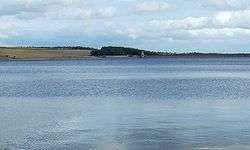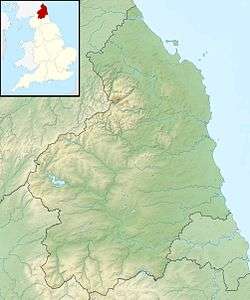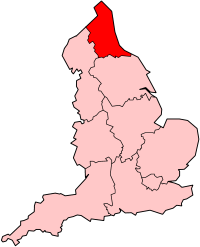Derwent Reservoir (North East England)
Derwent Reservoir is a reservoir on the River Derwent, on the border between County Durham and Northumberland, in England. It is west of Consett. It is one of the biggest inland waters in England. It is 3.5 miles (5.6 km) long) and covers an area of 4 km² and has a maximum depth of 100 ft (30m) and when full, holds 11,000 million gallons (50,000,000m³).[1]
| Derwent Reservoir | |
|---|---|
 Derwent Reservoir | |
 Derwent Reservoir | |
| Location | County Durham / Northumberland |
| Coordinates | 54°52′0″N 1°59′0″W |
| Lake type | Reservoir |
| Primary inflows | River Derwent |
| Primary outflows | River Derwent |
| Basin countries | United Kingdom |
The reservoir is a key part of the water supply network in north east England (which is owned and managed by Northumbrian Water) as it is the principal water source for the Tyne and Wear metropolitan area supplying 28,000,000 imperial gallons (130,000,000 l; 34,000,000 US gal) per day.[2] The reservoir was first proposed in 1957 when the Sunderland and South Shields Water Company promoted the Derwent Water Order. Building work began on the reservoir in 1960, and it was opened in July 1967 by Princess Alexandra.[3] Unlike other reservoirs in Northern England that are flooded valleys with a dam head, Derwent was dug out of the ground and the earth removed was used in its dam head.[4]
The flow of the River Derwent can be supplemented, when necessary, by water transferred from the much larger Kielder Water in Northumberland. However this cannot top up the reservoir itself.
Sediment within the reservoir has been found to contain elevated levels of zinc, lead and cadmium. These have drained into the reservoir from areas of previous mining activity around Blanchland. Consequently, populations of macroscopic plants in the reservoir are relatively low.[5]
Derwent Reservoir also hosts a sailing club, which holds many events throughout the year, including windsurfing, sailing, running and triathlons. The area around the reservoir hosts the annual Tour of the Reservoir cycle race.[6]
The reservoir also has hydro electric plant installed, with a rating of 97 kilowatts.[7]
References
- "Derwent-facts for 40 years" (PDF). www.nwl.co.uk. Northumbrian Water Plc. Retrieved 15 July 2012.
- "Derwent Reservoir walks, rides and wildlife" (PDF). northpennines.org.uk. North Pennines AONB Partnership. Retrieved 5 January 2017.
- Henderson, Tony (16 July 2007). "Landmark reservoir turns 40 this year". journallive. Retrieved 5 January 2017.
- "Derwent Reservoir and Pow Hill Country Park" (PDF). explorenorthpennines.org.uk. North Pennines AONB Partnership. Retrieved 5 January 2017.
- Harding, JPC, Whitten, BA (1978) Zinc, Cadmium and Lead in Water, Sediment and Submerged Plants of the Derwent Reservoir, Northern England. Water Research, Vol. 12, p307-316.
- "Tougher reservoir race brings top names to the region" (Press release). Northumbrian Water. 24 April 2013. Retrieved 26 July 2015.
- "Derwent". Renewable Energy Association. Archived from the original on 27 July 2011. Retrieved 5 August 2009.
External links
![]()
- Derwent Reservoir Sailing Club
- Derwent Reservoir Trout Fishing
- Fine Old Ales and Barley Wine is a beer-making book by Philip Atkinson fictitiously set in the pub 'The Woodcock,' which was drowned when the Derwent Reservoir was built.
